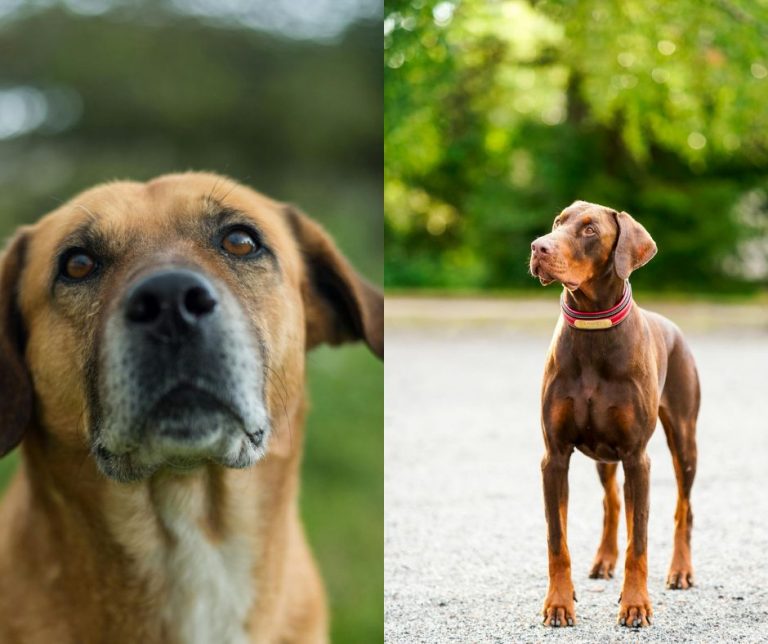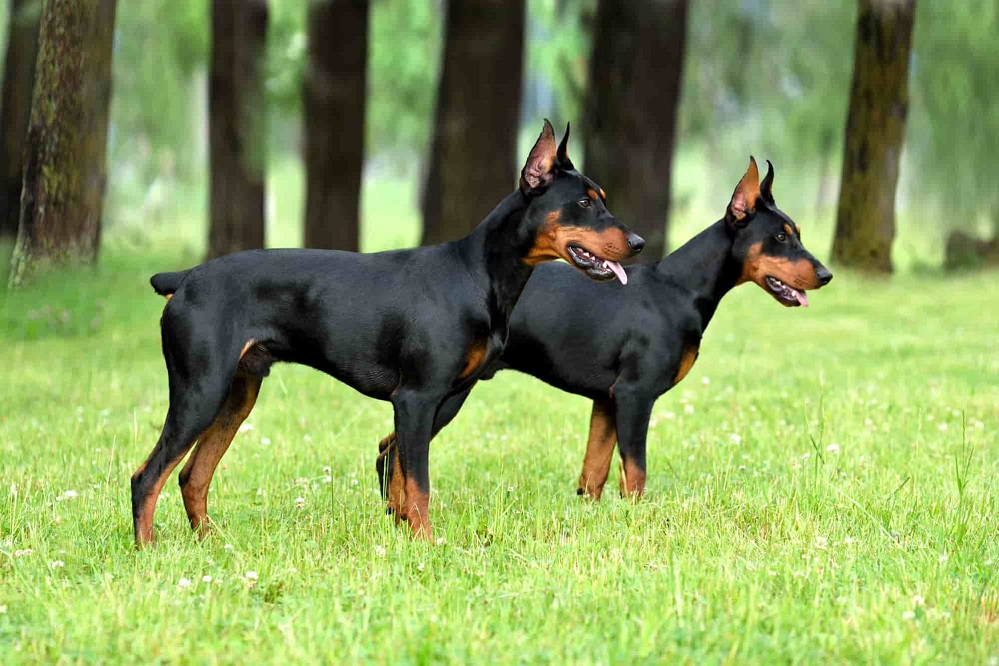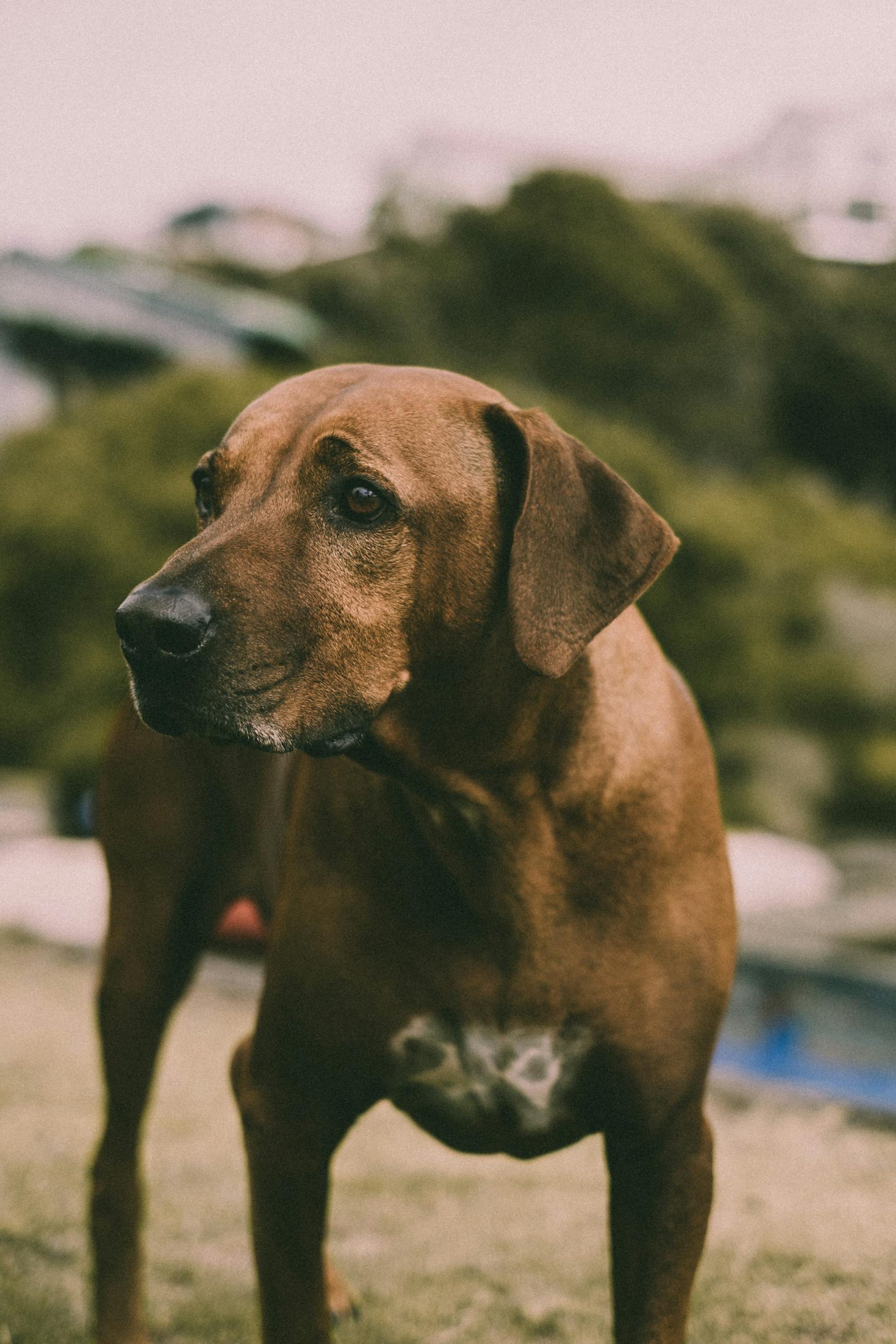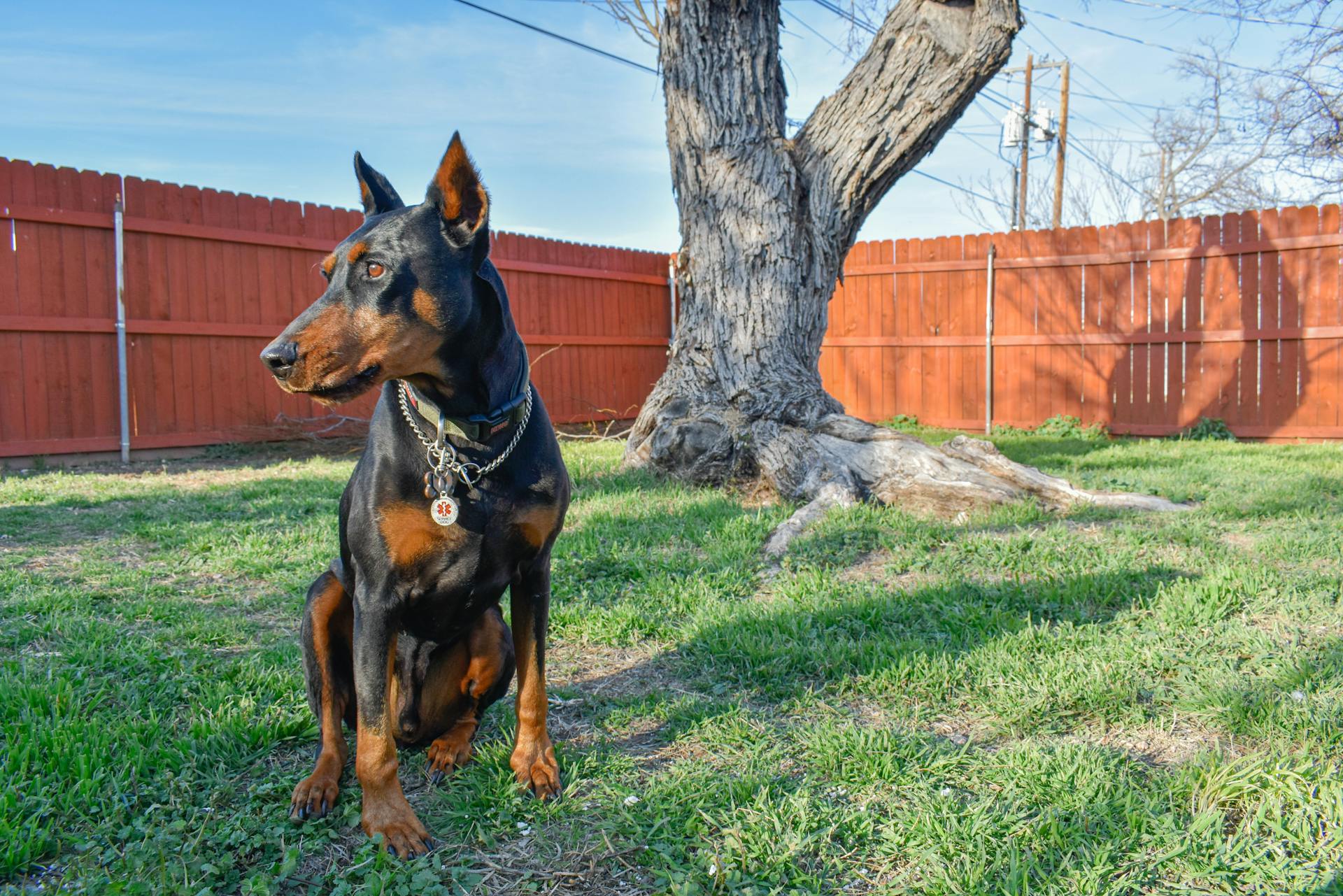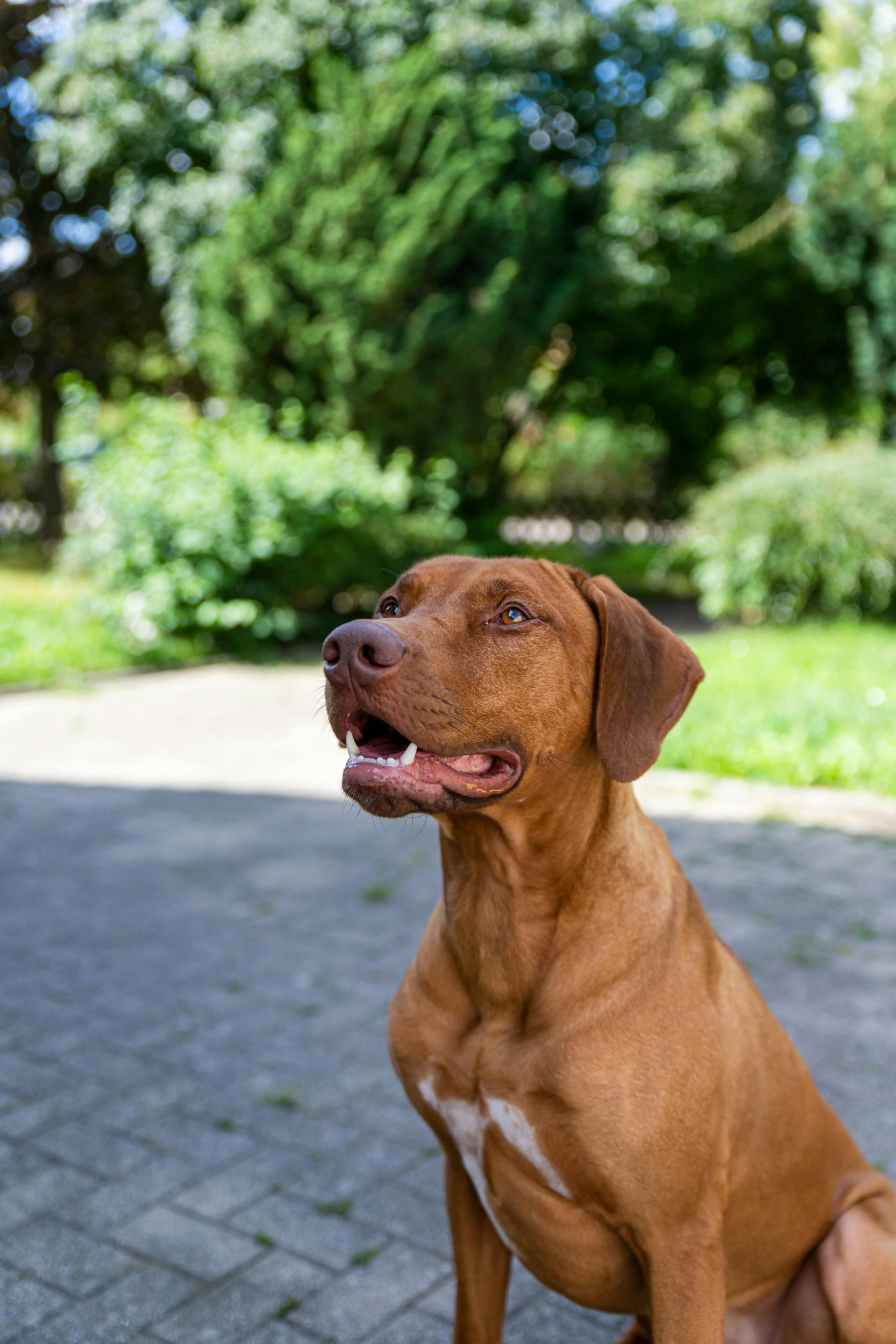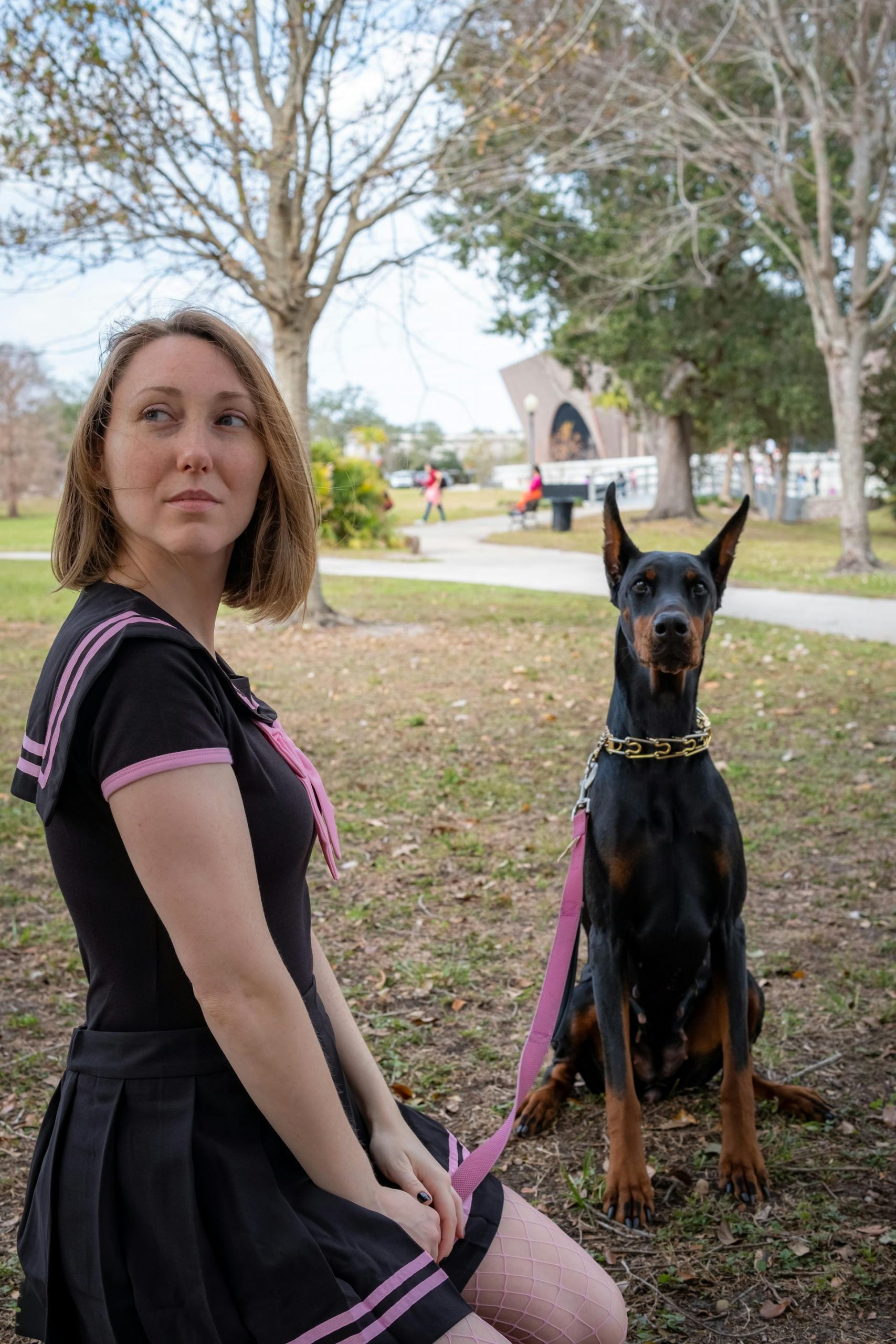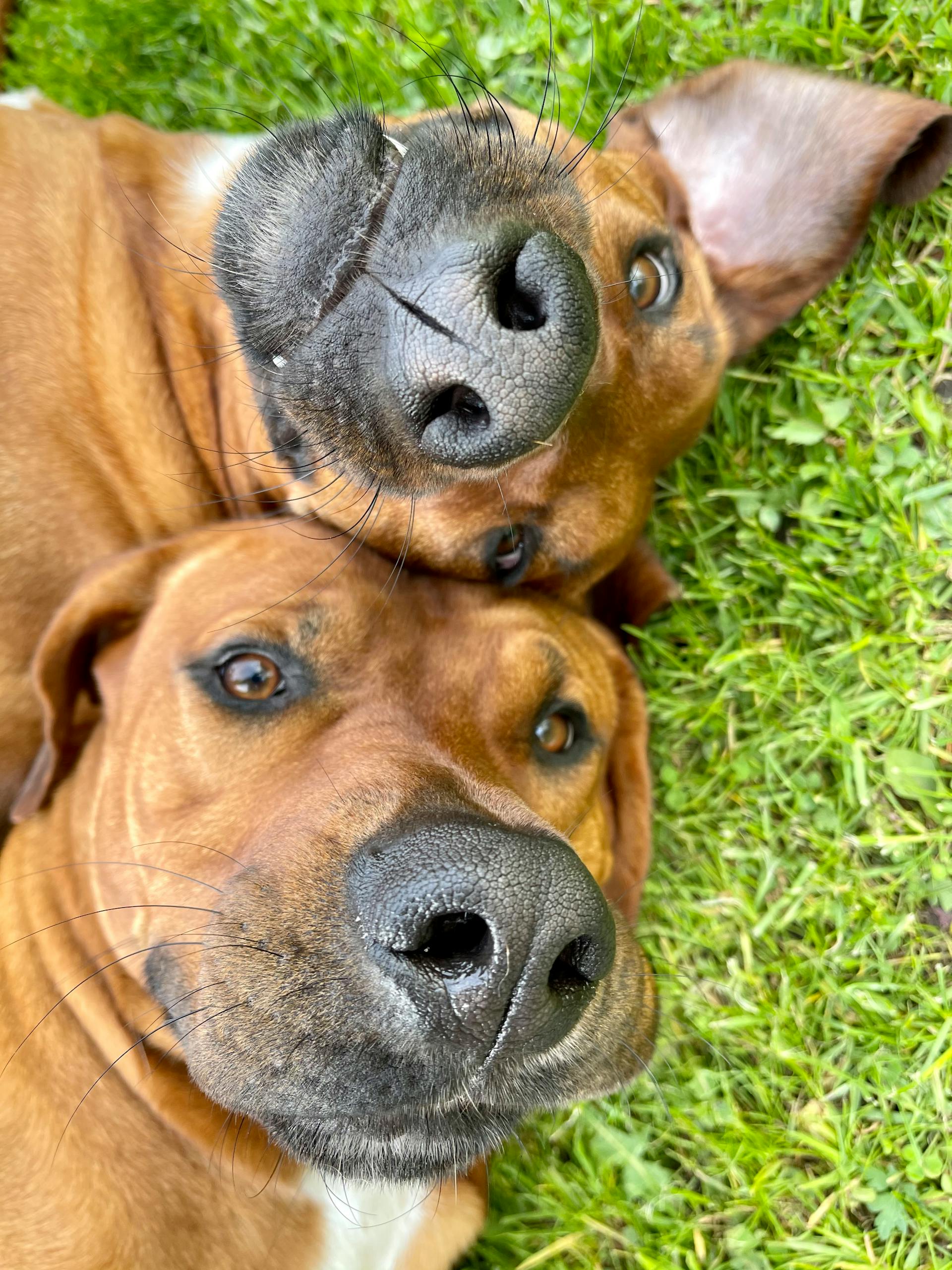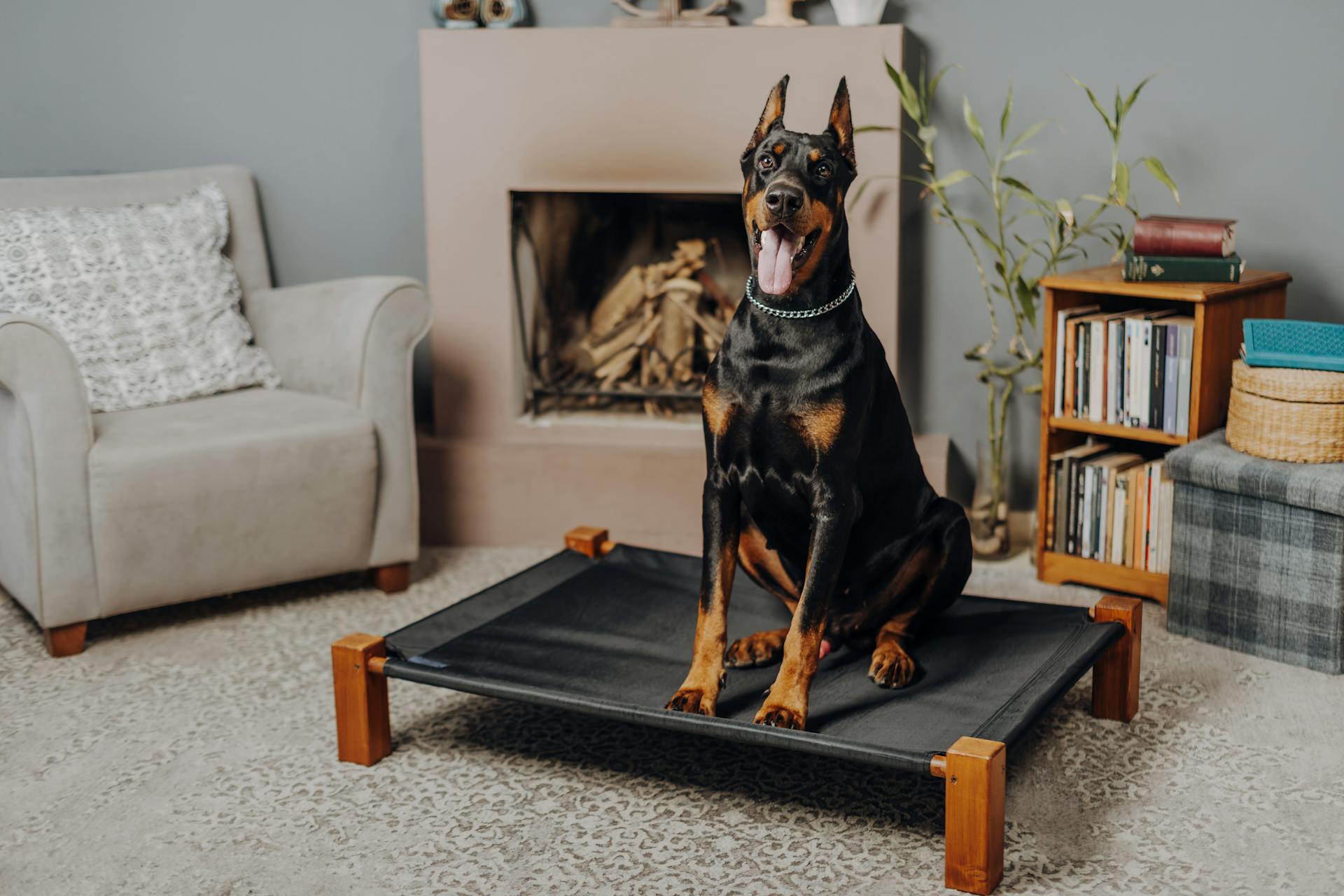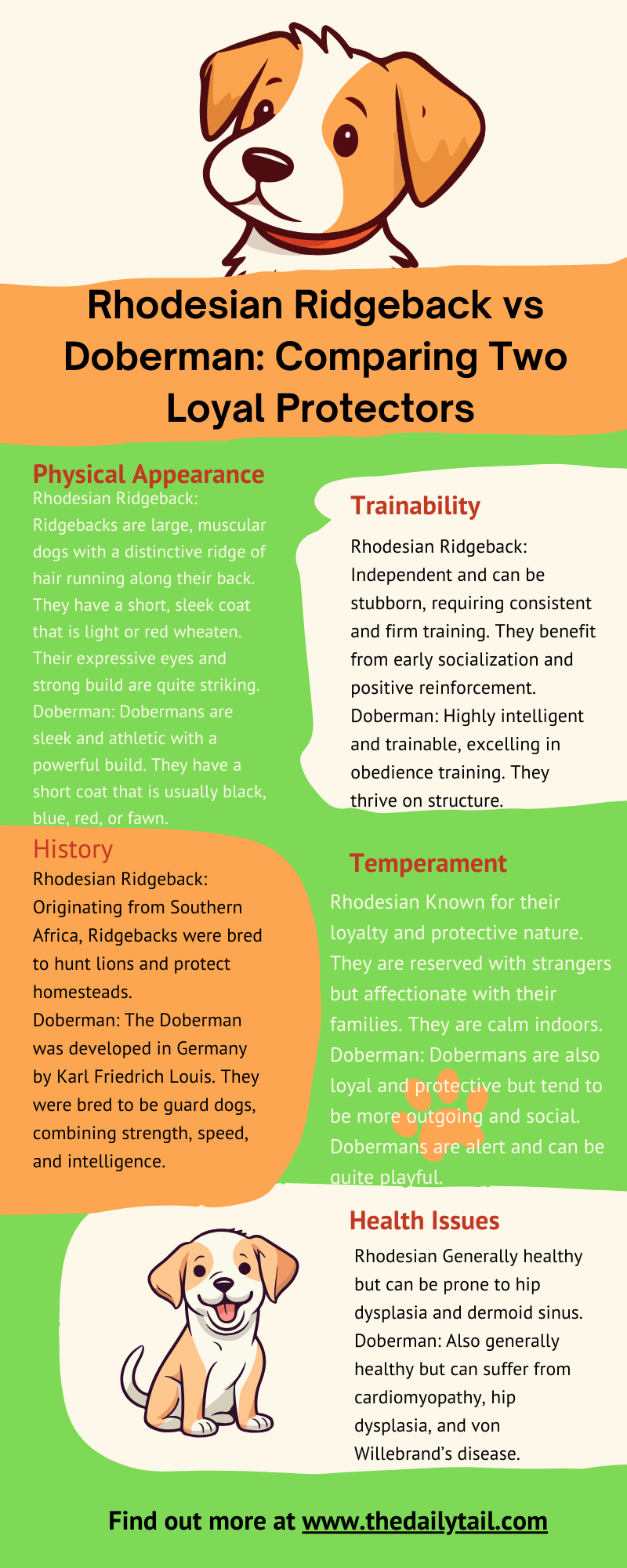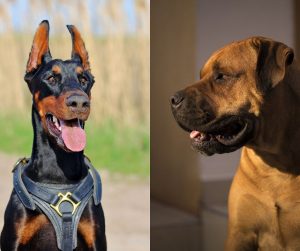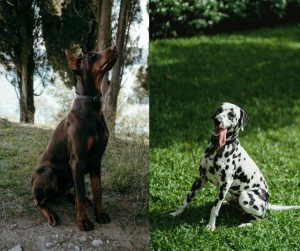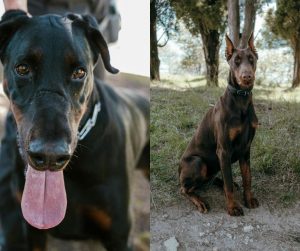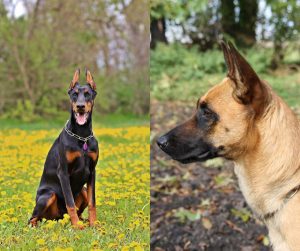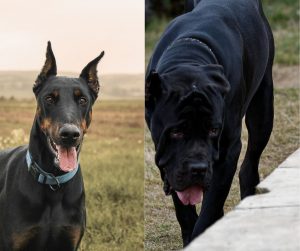The Rhodesian Ridgeback and the Doberman Pinscher are both highly regarded breeds known for their distinctive physical traits and dynamic personalities. Each breed has its own unique heritage. The Rhodesian Ridgeback hails from Southern Africa and was initially bred to hunt lions. Meanwhile, the Doberman Pinscher originated in Germany as a guard dog.
They share the commonality of being strong, resilient, and deeply loyal to their families. They exhibit some similarities in their roles as protection dogs but differ vastly in their appearance and some aspects of their temperaments.
Understanding the needs and characteristics of the Rhodesian Ridgeback and the Doberman Pinscher can be crucial for prospective dog owners.
Rhodesian Ridgebacks are known for their independent nature and affectionate disposition towards their family. On the other hand, Dobermans are recognized for their alertness and intelligence.
Training and obedience are key for both breeds to ensure they develop into well-behaved companions. Their exercise needs are also significant, as both dogs are energetic and require regular physical activity to maintain their health and happiness.
As a longtime dog owner and enthusiast, I know how challenging choosing between two breeds can be. That is why I want to help you make an informed decision. Which is your choice? Rhodesian Ridgeback vs Doberman Pinscher? Let’s go!
Key Takeaways
- Rhodesian Ridgebacks and Dobermans are both strong and protective, suited for families with different lifestyles
- Proper training and regular exercise are essential for both breeds to thrive
- Potential owners should consider each breed’s health, lifespan, and role as family pets before making a decision
Breed Origins
When looking at dog breeds like the Rhodesian Ridgeback and the Doberman, it’s important to understand where they came from. Their history gives us clues about why they act the way they do and how they became the pups we love today.
History of the Rhodesian Ridgeback
The Rhodesian Ridgeback has its roots in Southern Africa, where it was bred by Boer farmers in the 16th century. The distinctive ‘ridge’ on its back comes from a dog breed called the Khoikhoi, which was crossed with early European breeds such as Mastiffs and Greyhounds. These dogs were not just companions; they were tough hunters that could fend off dangerous animals like lions.
History of the Doberman
The Doberman breed started in the late 19th century in Germany. A tax collector named Louis Dobermann wanted a loyal and protective companion during his rounds. He started to breed various dogs with the aim of creating a strong, intelligent guardian. This included mixing breeds like the Rottweiler, the German Pinscher, and the Weimaraner, among others. Thanks to Dobermann’s efforts, the breed quickly gained a reputation for being fearless and dedicated.
Nowadays, the Doberman is considered among the best working dogs and protective dogs, alongside the German Shepherd, Rottweiler, Cane Corso, and others.
Physical Characteristics
If you want to understand the differences between Rhodesian Ridgeback vs Doberman Pinscher, taking a close look at their physical traits is a great place to start. There’s a bunch to talk about, from their unique features to their coats, so let’s dive in.
Rhodesian Ridgeback Features
Size: She typically stands about 24 to 27 inches tall at the shoulder and weighs in the ballpark of 70 to 85 pounds for males and 65 to 75 pounds for females. Unique Trait: The tell-tale sign of a Ridgeback is the ridge of hair running along her back, which grows in the opposite direction of the rest of her coat.
Doberman Pinscher Features
Size: In comparison, he’s quite the athlete, standing a tad taller at 26 to 28 inches for the guys and 24 to 26 inches for the ladies. Weight-wise, males range from a solid 75 to 100 pounds, while females hover around 60 to 90 pounds. Ears and Tail: Often, you’ll see a Doberman with ears and a tail that look quite different compared to other dogs—that’s because they’re sometimes cropped and docked.’
Coat Comparison
Rhodesian Ridgeback: She sports a short, dense coat that’s slick to the touch and fairly easy to care for. Doberman Pinscher: His coat is also short, but it’s got a sleek look that requires minimal fuss to keep it looking sharp.
Temperament and Personality
The choice between Rhodesian Ridgeback or a Doberman Pinscher as a pet definitely comes down to understanding their distinct temperaments. Both dog breeds exhibit a strong love for their families, are protective, and show a high level of intelligence, but their approaches to these traits can differ.
Ridgeback Temperament
Rhodesian Ridgebacks are known to be gentle and affectionate with their families, displaying a caring nature. They are often independent-minded and carry themselves with a dignified air. Despite their strong will, these dogs are deeply loyal and can be very loving, forming strong attachments to their people. They are also quite intelligent and able to learn quickly, though sometimes their independent nature requires a patient and consistent training approach. Ridgebacks are protective but are typically not aggressive without cause.
Doberman Temperament
Doberman Pinschers, on the other hand, embody a temperament of being energetic, watchful, determined, and alert. These dogs are famed for their fearlessness and obedience. They are incredibly loyal to their family, often forming a strong bond with a particular person. Dobermans are highly intelligent and excel in various forms of training, making them adaptable to a range of roles, from family companions to working dogs.
While they are known for being protective, their aggression is usually in line with their role as a guardian and is controlled when properly trained.
Training and Obedience
When it comes to teaching a dog, it’s like being a teacher in a classroom. You’ve got to know your students. Some kids learn with a gentle nudge; others need clear lines. That’s exactly how it is with training Rhodesian Ridgebacks and training Dobermans. They’re unique dogs with very different personalities.
Training a Ridgeback
Training a Rhodesian Ridgeback takes patience. They’re smart, sure, but they’re also pretty independent. Think of them as the kid in class who’s super clever but doesn’t always see the point of following rules. They need training that’s firm but fair.
Start early because pups are easier to teach than full-grown hounds. Use lots of rewards and keep it fun. If a Ridgeback gets bored, they’ll find their own things to do, which might not be what you want.
- Key Training Points:
- Patience is essential: Ridgebacks can be stubborn
- Consistency: They learn best with clear and consistent training methods
- Positive reinforcement: Praise and treats work wonders
Some common problems you might face are that they can be too protective and sometimes a little too confident. But get the training right, and you’ll have a loyal and loving friend for life.
Training a Doberman
Dobermans, on the other hand, are like the eager students. They’re super smart – one of the top-of-the-class breeds for intelligence. They soak up obedience training like a sponge and they love to please, which is a huge plus.
Start training them early too, and you’ll be amazed at what they can learn. Just remember, they need a lot of mental exercise.
- Key Training Points:
- Mental stimulation: Keep their sharp brains busy to prevent mischief
- Strong leadership: They respond well to confident and clear training
- Exercise: A happy Doberman is a well-exercised one; this helps in keeping training sessions engaging
Dobermans love having tasks and can sometimes get protective. But provide them with the right guidance, and they’ll turn out to be the most reliable and obedient companions.
Exercise and Activity Needs
When we talk about keeping dogs happy, a big part of that is making sure they get enough exercise. Both the Rhodesian Ridgeback and the Doberman have high energy levels and need a good amount of activity to stay healthy and content.
Ridgeback Exercise Requirements
The Rhodesian Ridgeback is a breed that enjoys staying active. While they can be calm when they’re in their home setting, they still need a daily outlet for their energy.
A long walk or a run is a great way to meet this need. They love having a task, like playing fetch or participating in agility training, to keep their minds as exercised as their bodies. Their athletic ability also makes them good companions for hikes and other outdoor family activities.
Doberman Exercise Requirements
Dobermans, on the other hand, are a powerhouse when it comes to energy. They require vigorous daily exercise to keep their muscles strong and their minds sharp.
Activities like running, playing interactive games, and taking part in dog sports are ideal for a Doberman. The home they live in should have space for them to move around freely.
For families, involving a Doberman in activities like jogging or playing in a secure yard can be a good way to bond with the dog while helping it burn off steam.
Health and Lifespan
When choosing between a Rhodesian Ridgeback and a Doberman, it’s important to understand their health and how long they might be part of your family. Both breeds face their own specific health challenges, so let’s get into what those are, keeping it straight to the point.
Ridgeback Health Issues
Rhodesian Ridgebacks are tough dogs originally bred to hunt, but even they have a few health concerns to look out for:
- Hip dysplasia: It’s a pretty common issue in large dogs where the hip joint doesn’t fit together perfectly, which can lead to arthritis or pain as they grow older
- Dermoid sinus: Specific to Ridgebacks, it’s a kind of tube-like skin issue they can be born with, and sometimes it needs surgery to fix it up
- Thyroid problems: This can mess with their energy levels and weight, but it’s usually manageable with medication
These dogs are often compared to a marathon runner – they’ve got strength and endurance.
Doberman Health Issues
Dobermans, known for their sleek looks and sharp minds, have a few health issues of their own:
- Cardiomyopathy: It’s a fancy word for a bigger heart problem that’s kind of common in Dobermans. It can be serious, so regular check-ups are a must
- Wobbler syndrome: This can make them walk funny because of spine issues. It’s something worth watching out for as they grow
- Bloat: It’s a scary one where their stomach can twist after eating a lot fast or exercising too soon after mealtime. It’s an emergency situation
Role as Family and Protection Dogs
If you are considering dog breeds that keep a careful eye on homes and bring joy to families, the Rhodesian Ridgeback and Doberman Pinscher both have standout qualities. They’re known for their loyalty and distinct protective instincts, making them popular choices for those looking for a pet that can also look out for the household.
Ridgeback in the Family
The Rhodesian Ridgeback, originally bred to track and keep lions at bay in Africa, is a natural protector. At home, they’re gentle giants, often showing a calm and loving demeanor toward the family. Despite their size and protective nature, don’t expect them to be overly aggressive; they reserve their guarding skills for actual threats. Ridgebacks are more than happy to spend time with their people, being part of family activities and playing in the yard.
Doberman as a Protector
On the flip side, the Doberman Pinscher’s reputation as a protector is well earned. Developed in Germany as a guard dog, their history includes working alongside police and military, showcasing their fearless and alert nature. As family pets, Dobermans are fiercely loyal. They are highly trainable, which, coupled with their natural instinct to protect, makes them excellent guard dogs for the home.
With proper socialization, they’re also kind-hearted with family, often forming a special bond with their owners.
Adoption and Care
When you’re thinking about bringing a dog into your home, it’s like deciding on a new family member. You want to be sure you’re making the right choice and are prepared for the responsibilities ahead.
Choosing the Right Breed for Your Home
When picking between a Rhodesian Ridgeback and a Doberman, think about your living situation.
Ridgebacks are laid-back, loyal, and get on well with their human buddies. They do need a yard to stretch their legs, though.
Dobermans are also loyal, and they’re super smart and active. They’ll fit into a family just fine, but they do have loads of energy, so be ready to provide them with lots of exercise.
Here’s what to ask yourself before deciding:
- Space: Do you have enough room for a large dog to roam around?
- Time: Can you commit to walking, training, and playing with your dog every day?
- Experience: Have you had a big dog before, and do you know how to handle them?
Costs and Responsibilities of Ownership
Puppies aren’t just cute; buying one means you’ll be caring for it for its whole life. This comes with costs, not just in money, but in time and responsibility as well. Here’s the rundown:
Money:
- Initial Cost: Expect to spend between $1,000 to $2,500 for a Ridgeback puppy. You’ll spend a bit less for a Doberman.
- Ongoing Costs:
- Food
- Vet check-ups and vaccinations
- Heartworm and flea prevention
- Grooming needs
- Possible training classes
Responsibilities:
- Training: You’ve got to teach them how to behave, especially if they’ve got size and strength
- Healthcare: Keeping your companion healthy means regular vet visits
- Legal: Don’t forget, you may need a license for your dog, depending on where you live
Don’t overlook rescue options, either. Sometimes older dogs need homes, and they can make great companions without the extra work that comes with a puppy.

